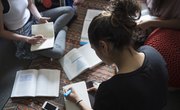Every classroom has a diverse group of students with a variety of learning styles. It's easy to see the various quirks and peculiarities that students manifest during the learning process with obstacles to overcome and learning difficulties to grapple with. However, being aware of the various learning styles and seeing their strengths will greatly enhance the learning process.
If you’re a teacher, being aware of the different types of learners in your classroom and recognizing the strengths and weaknesses of every student will enable you to better deliver the material, make your classes more enjoyable for everyone, and make sure the material stays with them for long after the exam. If you’re a student, becoming aware of your individual learning style as early as possible will teach you about yourself, your strengths and weaknesses, and give you confidence as you progress from one learning environment to the next.
Different Types of Learners in the Classroom
There are several different models to classify learning styles, but all of them describe the different ways people process and internalize new information, how they prefer to structure their learning, and how they view themselves in relation to others and the world.
One of the most well-known and accepted models of classifying learning styles is the VARK model developed by Neil Fleming, a teacher from New Zealand, in 1987. The VARK model classifies learners into four types based on how they take in new material, highlighting the strengths and weaknesses of each and offering teaching strategies and study tips. The four types described by the VARK model are visual learners, auditory learners, reading/writing learners and kinesthetic learners (hence the name VARK).
Visual learners absorb new material best when it's presented to them visually, for instance through graphs, maps, charts and so on. Their learning is enhanced with patterns, shapes and colors. They prefer visual instructions, they like planning, are not easily distracted and are usually very observant. They are often seen doodling in their notes.
Auditory learners learn best when new information is spoken out loud and internalize new concepts best when they're explained to them verbally. They may often talk to themselves or hum when solving a problem. They often need to talk through a problem to find a solution or generate ideas, rather than think first and speak later. These students greatly benefit from group discussions, and audio recordings of lessons that they can listen to later. Auditory learners may also be easily distracted and often have a good ear for music.
Reading and writing learners best process new material when it's presented as text. They take a lot of notes during lectures and benefit from rereading them. They like learning from textbooks and like working with handouts and workbooks.
Kinesthetic learners (also sometimes called 'physical' or 'tactile' learners) are those who best process new material through physical or tactile ways and through engaging with their physical environment directly. To learn, they needs lots of hands on experiences. For instance, they best acquire math concepts by manipulating objects and science concepts by recreating experiments. They may find it hard to sit still for long periods of time, may start shaking their leg or pacing around the room when bored or agitated, fidget with objects or walk around the room when thinking.
Teaching Strategies for Different Learning Styles
While the VARK model of learning styles is widely accepted, some warn that taking it too literally and pigeonholing students into specific learning styles may actually take away from learning and limit their experiences. Still, being aware of the different types of learners in the classroom (while keeping in mind that many students may fit into more than one style) will help the teacher understand the students’ individual differences and challenges.
If the teacher is aware of the many different learning styles and the types of learning difficulties present in the classroom, she or he will know that a student who begins to fidget when asked to sit still for long periods of time isn't being disrespectful but is simply having a hard time focusing because she or he may be a kinesthetic learner. That student who is constantly doodling isn't bored with the lecture but quite the opposite: As a visual learner, doodling helps her focus. And that student who raises her hand to speak out often, perhaps more often, you might think, than she has something valuable to say, isn't trying to stand out or get your attention or be disruptive: She is simply an auditory learner who processes information best while talking it out.
As a teacher, you can plan to include various types of activities during your classes to accommodate all possible learning styles. Instead of doing a traditional lecture followed by a question period, consider incorporating various activities to accommodate different learning styles.
For auditory learners, consider including group discussions, and give them opportunities to explain the concepts to others verbally. If possible, try to seat them away from distractions. If you can, record your lectures on audio or video or let them do so, as these students don't learn well from written notes.
To accommodate visual learners, make sure to include lots of stimulating visual material like colors, shapes and patterns into your lecture notes and overheads. Provide maps, graphs and diagrams to convey concepts whenever possible, and encourage these students to make mind maps and their own graphs and flowcharts.
To help your kinesthetic learners internalize new material, try to include some hands on activities in your classes. When this isn't possible, let them knit, listen standing up and take breaks to move around.
Finally, don’t ditch the traditional textbook and handouts as they're what helps your reading and writing learners learn best. Encourage them to make written notes from diagrams and charts, as well as write down the results of an experiment or a group discussion.
Study Tips for Different Learning Types
If you’re a student, remember that the teacher can only do so much in the classroom. Ultimately, it’s up to you to figure out your learning style. You may have been chastised as a young child for not being able to sit still for more than a few minutes in the classroom, or for daydreaming or for speaking too much. If you’re entering high school or college, it’s time to take ownership of these traits of your personality and your learning style. There's nothing wrong, despite what you may have been led to believe, if you were unlucky with your teachers in elementary school. Figure out these traits, own them and use them to your advantage. They are your allies, not your enemies.
Also, remember that a lot of learners are somewhere in between two or three learning styles. You might have preferences for a particular learning style on some occasions or for some subjects.
If you can’t take information through verbal instruction but must take it in visually, don’t force yourself to try and get better at it. Take plenty of notes, make mind maps and doodle if you have too.
If you’re an auditory learner, listen to audiobooks and audio recordings of a lecture, consider explaining a difficult concept to a friend to better learn it yourself, or explain it out loud to yourself if you have to.
If you’re a kinesthetic learner, remember that your inability to sit still isn't a hindrance to your learning, but quite the opposite: By moving around and “getting your hands dirty,” you learn best. Allow yourself to do whatever your body wants while listening to an audio recording of a lecture, be it moving around, knitting or tossing a tennis ball. Get a standing desk or a treadmill desk to help you focus when you have to do something that requires you to stay in one location.
If you’re a reading and writing learner, you’re in luck, as the traditional classroom is usually still structured to accommodate your learning style best. Take notes, read the textbook or ask for (more) handouts and worksheets to help you cement the material you learned in class. Write your way through your learning processes even if it’s just for yourself and not through reports you have to hand in.
Other Types of Learning Styles
The VARK model is one the best known learning style theories, and perhaps the one that is easiest to translate into teaching recommendations and study tips. But there are other theories of learning styles out there.
The Jungian Learning styles theory is based on Jung’s theory that classifies personalities along four basic dimensions:
Extroversion vs. Introversion
Sensation vs. Intuition
Thinking vs. Feeling
Judging vs. Perceiving
Jung’s theory of personality is the basis for the famous Myers-Briggs Test for personality types which distinguishes 16 different personalities based on these four dimensions. You can also use these dimensions to identify your learning style.
For instance, if you’re an extrovert, you might enjoy working in groups and gathering information from outside sources. You don’t hesitate to offer opinions and may thrive by taking a leadership position. You learn from direct experiences rather than watching or reflecting. Introverts, on the other hand, prefer solitary work and lots of watching and reflecting. They’re best at generating ideas when they’re given time to work alone, they're self-motivated and independent learners, they prefer to listen, watch and reflect rather than to lead. Introverts may look like they’re not participating, but they’re taking everything in. It’s not uncommon for a shy and introverted student who was barely noticed during the class to do brilliantly on the exam.
While introversion vs extroversion may be the most relevant dimension of personality to implement for learning styles, it's good to be aware of the the other three dimensions and how they influence the learning process.
Sensing learners focus on the present, are practical and tend to solve problems based on their experiences. They like routines and observing the world around them. Intuitive learners solve problems and make decisions based on the world of possibilities rather than past experiences, they tend to imagine possible outcomes, view the larger picture and focus on possible worlds rather than zooming in on the here and now as sensing learners do. They are good at abstract thinking and developing theories.
Thinking learners like to make decisions based on logic and reasoning. They tend to have very clear ideas of right vs. wrong and fair vs. unfair. They tend to focus on the logical structure of information rather than its emotional impact. Feeling learners, on the other hand, learn and make choices based on feeling rather than thinking. They’re in tune with their own feelings and keenly aware of the feelings of other people, they like social harmony and avoid conflict and make their decisions based on their initial feelings.
Judging learners prefer structure and organization, have strong opinions and tend to be decisive. Unlike judging learners, perceiving learners tend to change their minds often or at least keep all options open. They don’t like strict deadlines and often have several projects going at once. Although they tend to be more flexible than judging learners, they sometimes have trouble making decisions.
If you’re a teacher, it's worth learning as much as possible about the existing learning styles and types of students in your classroom. You may not be able to accommodate all of them in every lesson, but being aware of these styles will make you more tolerant and understanding of their difficulties. You can make accommodations for their coping strategies and not be personally offended by someone chewing gum or doodling or daydreaming in your class.
If you’re a student, it's imperative that you learn as much as possible about your own learning style, as doing so will help you not only get through high school and college, but empower you to use your strengths and mitigate your weaknesses throughout your career and personal life.
Related Articles
References
Writer Bio
Tanya Mozias Slavin is a former academic and language teacher. She writes about education and linguistic technology, and has published articles in the Washington Post, Fast Company, CBC and other places. Find her at www.tanyamoziasslavin.com









